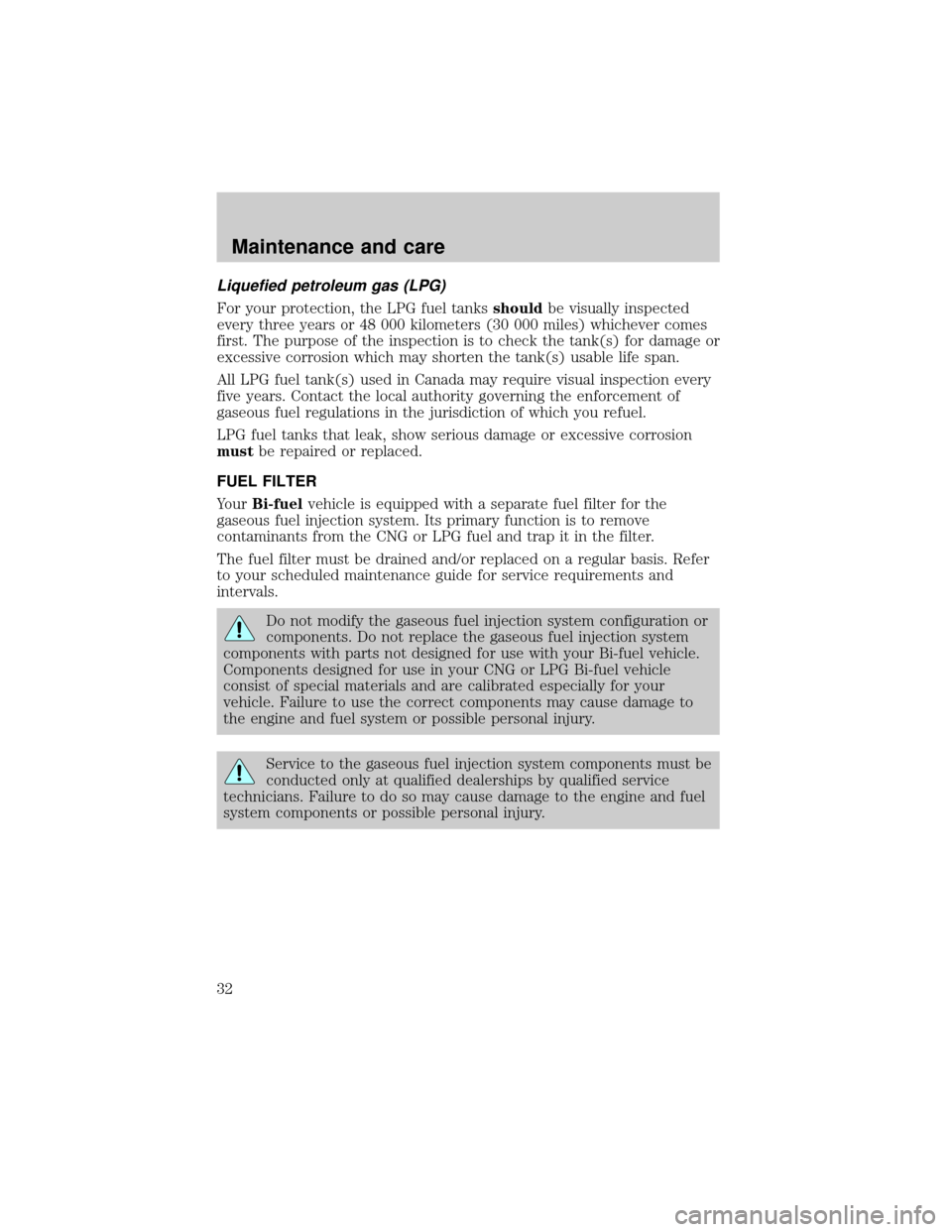Page 8 of 32

These two labels are located in the
engine compartment and contain
diagnostic information for your
gaseous fuel injection system.
NOTICE (diagnosis testing):DO NOT perform the following diagnostic
tests while operating in Alternate Fuel Mode:
KOER (Key On - Engine Running) or
KOEO (Key On - Engine Off)
Test equipment will display:
"- UNABLE TO PERFORM TEST/FUNCTION
- CONDITIONS NOT CORRECT
- CHECK SHOP MANUAL FOR PROPER
TEST/FUNCTION REQUIREMENTS."
when performed in Alternate Fuel mode. This
is NOT an indication of a malfunction. Tests
must be performed in gasoline mode. Fuel
selector switch must be set to gasoline.
VACUUM HOSE DIAGRAM / SCHÉMA DU CONDUIT DÉPRESSIF
EMISSIONS
The GFI system does not affect vehicle emissions when running in
gasoline mode. The GFI system is transparent to the OEM system.
Emission control devices are neither removed or affected by the GFI
system.
ÉMANATIONS
Le systéme GFI n' affecte pas les émanations du véhicule lorsqu'il
fonctionne en mode d'essence. Le systéme GFI n' exerce aucune
action sur le systéme d' équipement d' origine. Les dispositifs
dépolluants ne sont ni ôtés ni affectés par le systéme GFI.
L1-183
Introduction
8
Page 15 of 32
WARNING LIGHTS
With the engine running, the ªCheck Engine/Service Engine Soonº
indicator light (depending upon application) will illuminate on the
instrument cluster when the On Board Diagnostics System and/or the
Gaseous Fuel Injection System detects a malfunction in one of the
engine's emission controls. For more information, refer toWarning light
and chimesin theInstrumentationchapter of your Owner's Guide and
this supplement.
If a malfunction of the Gaseous Fuel
Injection System is detected with
the engine running in the gaseous
fuel mode, the green indicator light
on the fuel selector switch will flash
on and off.
The warning lights may illuminate or flash on and off (depending upon
application) without a driveability concern being noted. The vehicle will
usually be drivable and will not require towing. Contact a qualified Ford
dealership at the first available opportunity.
GASALT
Instrumentation and controls
15
Page 31 of 32

Inspection and testing of the fuel tank(s) must be done by a qualified
Ford service technician, or by the local authority governing the
enforcement of gaseous fuel regulations in the jurisdiction of which you
refuel.
Some localities mandate a sticker be displayed showing the date of the
next required inspection. In localities requiring this sticker, refueling
station technicians arenot allowedto refill your gaseous fuel tank(s) if
the sticker is not visible or if the date has expired.
Refer to the following for more information regarding gaseous fuel tank
inspection and replacement requirements.
Compressed natural gas (CNG)
For your protection, the CNG fuel tanks require visual inspection every
three years or 48 000 kilometers (30 000 miles), whichever comes first.
The purpose of the inspection is to check for damage to the fuel tank(s)
or tank wrap which may shorten the tank(s) usable life span.
CNG fuel tanks that leak or show serious damagemustbe repaired or
replaced.
The expiration date for the tank replacement is stated on each tank
label. See instructions on fuel container for inspection and service life.
Inspection and expiration dates for
the CNG fuel tank(s) are listed on
this label. Depending upon
application this label can be located
in the engine compartment, on the
fuel filler door and on the fuel
tank(s).
Maintenance and care
31
Page 32 of 32

Liquefied petroleum gas (LPG)
For your protection, the LPG fuel tanksshouldbe visually inspected
every three years or 48 000 kilometers (30 000 miles) whichever comes
first. The purpose of the inspection is to check the tank(s) for damage or
excessive corrosion which may shorten the tank(s) usable life span.
All LPG fuel tank(s) used in Canada may require visual inspection every
five years. Contact the local authority governing the enforcement of
gaseous fuel regulations in the jurisdiction of which you refuel.
LPG fuel tanks that leak, show serious damage or excessive corrosion
mustbe repaired or replaced.
FUEL FILTER
YourBi-fuelvehicle is equipped with a separate fuel filter for the
gaseous fuel injection system. Its primary function is to remove
contaminants from the CNG or LPG fuel and trap it in the filter.
The fuel filter must be drained and/or replaced on a regular basis. Refer
to your scheduled maintenance guide for service requirements and
intervals.
Do not modify the gaseous fuel injection system configuration or
components. Do not replace the gaseous fuel injection system
components with parts not designed for use with your Bi-fuel vehicle.
Components designed for use in your CNG or LPG Bi-fuel vehicle
consist of special materials and are calibrated especially for your
vehicle. Failure to use the correct components may cause damage to
the engine and fuel system or possible personal injury.
Service to the gaseous fuel injection system components must be
conducted only at qualified dealerships by qualified service
technicians. Failure to do so may cause damage to the engine and fuel
system components or possible personal injury.
Maintenance and care
32